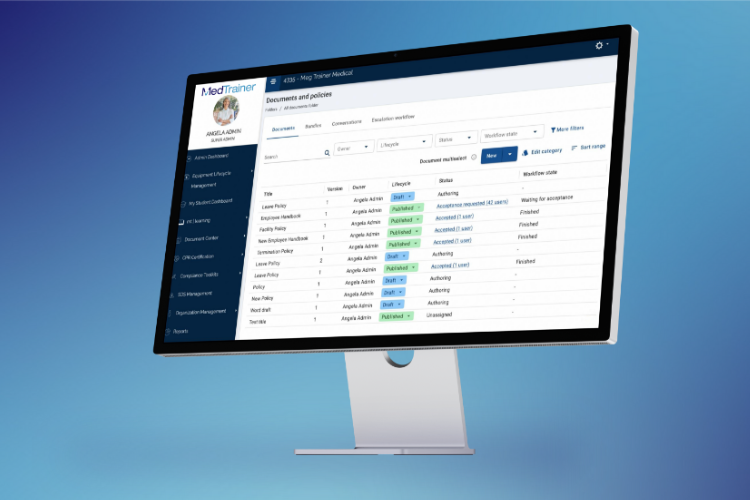Compliance is paramount in healthcare facilities. Staying abreast of compliance takes a full-time commitment, and often requires oversight tools like compliance management software. Yet, many healthcare organizations aren’t sure where to start when it comes to enabling their compliance teams. Organizations are often reactive instead of proactive — largely because they don’t have the foresight to identify and remedy compliance issues.
Let’s take a look at how compliance management software can help address these challenges head-on, and how to choose software that empowers your organization to get ahead of compliance — instead of falling behind it.
What Is Compliance Management Software?
Compliance management software is designed to assist healthcare organizations in managing and ensuring compliance within various regulatory requirements, industry standards, and internal policies. This type of software is specifically tailored to address the unique compliance challenges faced by healthcare providers, including hospitals, clinics, and other healthcare facilities. It helps streamline and automate compliance-related tasks to reduce manual efforts and minimize the risk of non-compliance.
How Does a Compliance Management System Work?
Compliance management software typically offers a range of features and functionalities to support healthcare organizations in achieving and maintaining compliance. These may include:
- Regulatory monitoring. The software keeps track of relevant regulations and standards applicable to the healthcare industry, providing updates and alerts about any changes or new requirements.
- Policy and procedure management. It enables organizations to create, document, and disseminate policies and procedures related to compliance. This ensures consistent adherence across the organization.
- Training and education. The software may include modules for delivering and tracking employee training and education on compliance-related topics. It can keep staff members knowledgeable about regulations and organizational policies.
- Audit and risk assessments. It facilitates the planning, execution, and documentation of internal audits and risk assessments. This helps healthcare organizations identify and address compliance gaps and vulnerabilities.
- Incident reporting and management. Compliance management software includes online incident reporting and tracking — such as breaches or violations — to ensure timely investigation and appropriate resolution.
- Documentation and record-keeping. It provides a centralized repository for storing and managing compliance-related documents such as policies, procedures, training records and audit reports. It also keeps them readily accessible for retrieval when needed.
- Reporting and analytics. Compliance management software offers reporting and analytics capabilities. This allows organizations to generate reports on compliance activities, performance metrics, and trends, which can aid in decision-making. It also demonstrates record of compliance to regulatory bodies.
Summed up, compliance management software offers a complete array of tools and resources to help healthcare organizations prioritize ongoing compliance in all its many facets.
What to Look for in a Compliance Management System
When searching for a compliance management system, consider several key factors to ensure its effectiveness in meeting your organization’s needs. Here are three essential aspects to look for in a compliance management system:
- Integrated system/unified platform. One of the primary features to consider is an integrated, unified platform that brings all compliance functions together in a single place. This eliminates the need for multiple, disjointed systems or manual processes, streamlining and centralizing compliance efforts. This includes policy management, training, auditing, and reporting.
- Industry-specific focus. Choose a system that’s tailored to address the specific compliance challenges and regulations faced by healthcare organizations, to ensure all necessary compliance elements are included. This industry-specific focus helps organizations stay up-to-date with evolving healthcare regulations and maintain compliance with standards such as HIPAA, HITECH and other relevant frameworks.
- Wide range of actions. A comprehensive compliance management system should offer a wide range of functionalities to support various compliance-related actions. These actions may include document storage and management, incident reporting, and safety data sheet (SDS) management, among others. Choose a system that brings organization and accessibility to your data and documents.
Keep in mind, these aren’t the only critical features to look for in compliance management software. It’s important to evaluate your needs for a compliance management tool and seek out a platform with specific solutions tailored around them.
How to Select Compliance Management Software
When selecting compliance management software, there are several key factors to consider. Here’s a list to help you choose the right software for your organization:
- Cloud-Based System. Cloud-based systems offer numerous advantages, including accessibility from anywhere with an internet connection, scalability to accommodate growing needs, automatic updates, and enhanced data security.
- Comprehensive Process Support. Look for software that enables you to upload and manage documents, policies and procedures, as well as facilitate the review and approval process. It should also provide a mechanism to send compliance documents to employees for attestation, ensuring they acknowledge and understand their responsibilities.
- Automation of Manual Tasks. Look for features such as document version control, notifications for document updates or expirations and automated workflows for review and approval processes. Automation not only saves time; it also ensures consistency and accuracy in compliance management.
- Real-Time Reporting. The software should provide customizable dashboards and reports that offer real-time insights into compliance metrics, trends, and areas that require attention. This enables proactive decision-making and helps identify potential compliance risks before they escalate.
- Pre-Built Plans and Templates. Consider software that offers pre-built plans and templates for various compliance requirements. For example, the software should provide pre-designed safety plans that can be quickly customized to your organization’s needs. These pre-built plans and templates save time and effort in creating compliance documents from scratch, ensuring that you meet regulatory requirements efficiently.
Prioritize these features based on your organization’s need for them, and look for platforms that check as many boxes as possible. Don’t forget to demo software before you take the plunge, so you know exactly what you’re getting!
If you’re looking for compliance management software, find out why MedTrainer should be on your list!

Streamline your compliance with MedTrainer
